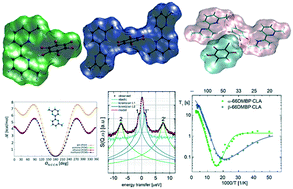The influence of structure on the methyl group dynamics of polymorphic complexes: 6,6′-dimethyl-2,2′-dipyridyl with halo derivatives of benzoquinone acids†
Abstract
Recently, interest in organic ferroelectrics or antiferroelectrics representing a metal-free perovskite-type has increased significantly. This interest results from the properties of organic systems. First of all, they do not have toxic metals in their structure. Therefore they are environmentally friendly. Also, the method of preparation, simple syntheses, and low-temperature processability increase their attractiveness in terms of application. In this paper, the above properties are associated with the proton dynamics in organic donor–acceptor systems. We present the comparison of the physicochemical properties of four molecular complexes containing the proton acceptor molecule, 6,6′-dimethyl-2,2′-bipyridyl (66DMBP), and one of three organic acid molecules belonging to the benzoquinone group. As proton donor molecules the organic acids: chloranilic, bromanilic and iodanilic acids have been chosen. We present the results of experiments concerning the determination of crystal structures, 1H NMR, inelastic neutron scattering (INS) and UV/vis spectra. In the theoretical part, we attempt to explain the influence of the crystallization method (a type of solvent) on transoid or cisoid arrangement of 66DMBP. In the theoretical approach, we focus on two forms of the complex with chloranilic acid, α-66DMBP·CLA and β-66DMBP·CLA, which undergo solid-to-solid phase transitions, at 380 and 317 K, respectively. We have chosen these examples because the α analogue possesses ferroelectric properties in a wide range of temperatures.



 Please wait while we load your content...
Please wait while we load your content...